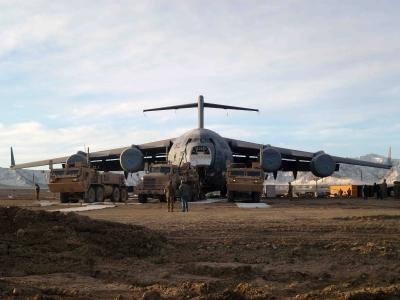Massive Aircraft Had To Be Rescued After A Runway Excursion
When a C-17 Globemaster III, recently landed and overran the runway due to inclement weather, the landing gear and other critical parts were damaged. Through months of planning and teamwork by the joint forces located on Forward Operating Base Shank in Logan Province, Afghanistan, this 282,500-pound aircraft was moved with no incidents from its location after the crash to a site where the service members and Boeing employees could get the aircraft back to operational readiness.

"As soon as the aircraft overran the runway, we were looking at planning and how to recover the aircraft," said Maj. Mel Ibarreta, the officer-in-charge of the 777th Expeditionary Prime BEEF Squadron on Forward Operating Base Shank. "We contacted the aircraft maintainers at Boeing and got an understanding of what they needed. Then we got the necessary pieces to move the equipment from landscapers needed to shift dirt to engineers to develop and test the plan and lay out the move."
"We were tasked with building the bridge the aircraft was going to be moved over to stage for repair," said Tech Sgt. Ursala Rothweiler, an engineer assistant assigned to the squadron. "Also included was completing dynamic cone penetration testing to assure that the bridge would hold the weight of the aircraft without sinking or giving way."
With the necessary equipment and personnel named, and the tasks being given, all that was left was the execution of the plan, moving the aircraft from the crash site to the repair site; a little more than a mile away. "By the time I got on the team, the plan was set and it was mostly time for execution of mission," said Army Sgt. Dennis Stout, the project non-commissioned officer in charge of personnel and equipment. "We were out here every day busting butt moving dirt and filling the areas needed to hold the weight of the huge bird, plus the equipment needed to pull the aircraft from its location to the objective."
With the preparation complete and the plan in place, all that was left was the rehearsal and the move itself. "The move went 100 percent better than I could have ever anticipated," said Army Sgt. 1st Class Pierre Dye, the construction operations sergeant for the 7th Engineer Battalion. "We planned on the move requiring around five hours and I was amazingly surprised it took less than an hour. But that goes to show you when Soldiers, Airmen and civilians alike all put their minds and effort into a joint task that nothing is impossible"
"What stands out the most to me about this whole affair is that it was a mixture of many, many people from many different sources, who all meshed together and worked extremely hard," said Army Lt. Col. Gilbert Mestler, the FOB Shank garrison commander. "Around 200 people were involved in the planning and execution of this move, from construction engineers, design engineers, Boeing employees, Air Force security police, Army military police, Army pathfinders -- all kinds of Soldiers, Airmen and civilians from many different fields have been involved in this effort.
"For a lot of those people this will be the culminating point of many weeks of effort from people of divergent fields," said Mestler. "And we're really proud of having successfully moved the aircraft without doing any more damage to the aircraft. As well as getting a C-17 back into the fleet, the runway should be back opened up to C-17 use for redeployment and deployment."
 ANN's Daily Aero-Linx (05.02.24)
ANN's Daily Aero-Linx (05.02.24) ANN's Daily Aero-Term (05.02.24): Touchdown Zone Lighting
ANN's Daily Aero-Term (05.02.24): Touchdown Zone Lighting Aero-News: Quote of the Day (05.02.24)
Aero-News: Quote of the Day (05.02.24) ANN FAQ: Contributing To Aero-TV
ANN FAQ: Contributing To Aero-TV NTSB Final Report: Cirrus Design Corp SR20
NTSB Final Report: Cirrus Design Corp SR20



